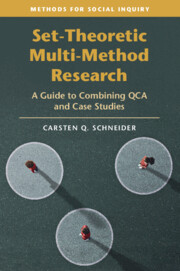7 - Conclusions – SMMR in Practice
Published online by Cambridge University Press: 22 February 2024
Summary
This concluding chapter discusses various aspects related to the use of SMMR: how does SMMR relate to existing advice for case selection; in which sequence should the different SMMR designs be applied; how should one choose among SMMR designs if all of them cannot be performed due to constraints (time, money, data, etc.); which types of sets (crisp or fuzzy) should one use when planning to perform SMMR; how can SMMR be fruitfully combined with theory evaluation, robustness tests, cluster diagnostics, and procedures that integrate time and temporality into the QCA? Learning goals: - Reflect on challenges in putting SMMR into practice - Understand the different ways in which to choose among the various SMMR designs - Learn about the implications of using different types of sets in SMMR - Develop ideas on how to combine SMMR with other, advanced tools in set-theoretic methods that share the feature of classifying cases - Further appreciate the full suit of SMMR designs as the yardstick for measures to be taken to strengthen descriptive and causal inference
Keywords
Information
- Type
- Chapter
- Information
- Set-Theoretic Multi-Method ResearchA Guide to Combining QCA and Case Studies, pp. 219 - 239Publisher: Cambridge University PressPrint publication year: 2024
